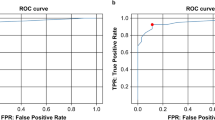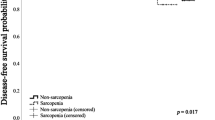Abstract
Purpose
Extraocular muscle enlargement (EOME) is most commonly associated with thyroid eye disease, but there are other causes. We report our outcomes of investigating and managing non-thyroid-related EOME (NTR-EOME).
Methods
Retrospective consecutive case series. Sixteen patients identified by clinical features and orbital imaging. Patient demographics, radiological features, and adjuvant tests including biopsy and final diagnosis were recorded.
Results
Mean age at presentation 59.3 years (range 24–89 years). Mean follow-up 3.2 years (range 3 months to 5.5 years). Superior rectus (SR) was most commonly involved muscle (8/16 cases) followed by lateral rectus (4/16). Of the 16 cases, 14 were associated with underlying systemic neoplasia (5 lymphoma, 5 metastatic carcinoma, and 4 presumed paraneoplastic syndrome). All SR enlargement was associated with underlying neoplasia. All patients underwent orbital imaging followed by systemic imaging based on clinical index of suspicion (14/16 patients (13 full body CT (FBCT), 1 mammography)). Positive systemic radiological findings were detected in 12/14 cases. Of the remaining 2 patients, 1 underwent full body positron emission tomography-computed tomography (FBPET-CT), which detected thyroid carcinoma, and the second patient underwent FBCT for staging following orbital biopsy showing lymphoma. Four patients (25%) died within 3 years of follow-up due to disseminated systemic malignancy.
Conclusions
All cases of NTR-EOME should be viewed with a high level of clinical suspicion for systemic neoplasia, especially when the SR is involved. FBCT can help to identify a primary systemic cause. FBPET-CT is best reserved for cases negative on FBCT or for staging and monitoring systemic disease. NTR-EOME can be associated with significant mortality (25%), hence warrants prompt and thorough systemic investigation.
Similar content being viewed by others
Log in or create a free account to read this content
Gain free access to this article, as well as selected content from this journal and more on nature.com
or
References
Lacey B, Chang W, Rootman J . Nonthyroid causes of extraocular muscle disease. Surv Ophthalmol 1999; 44: 187–213.
Patrinely J, Osborn A, Anderson R, Whiting AS . Computed tomographic features of nonthyroid extraocular muscle enlargement. Ophthalmology 1989; 96: 1038–1047.
Trokel S, Hilal S . Recognition and differential diagnosis of enlarged extraocular muscles in computed tomography. Am J Ophthalmol 1979; 87: 503–512.
Rothfus WE, Curtin HD . Extraocular muscle enlargement: a CT review. Radiology 1984; 151: 677–681.
Peyster RG, Hoover ED . Computerized Tomography in Orbital Disease and Neuro-ophthalmology. Year Book Medical Publishers: Chicago, IL, USA, 1984; 23–116.
Hornblass A, Jakobiec FA, Reifler DM, Mines J . Orbital lymphoid tumors located predominantly within extraocular muscles. Ophthalmology 1987; 94: 688–697.
Capone Jr A, Slamovits TL . Discrete metastasis of solid tumors to extraocular muscles. Arch Ophthalmol 1990; 108: 237–243.
Goldberg RA, Rootman J, Cline RA . Tumors metastatic to the orbit: a changing picture. Surv Ophthalmol 1990; 35: 1–24.
Volpe NJ, Albert DM . Metastatic and secondary orbital tumors. In : Albert DM, Jakobiec FA (eds). Principles and Practice of Ophthalmology Vol 3. WB Saunders: Philadelphia, PA, USA, 1994; 2027–2050.
Harstein ME, Grove Jr AS, Woog JJ . The role of the integrin family of adhesion molecules in the development of tumors metastatic to the orbit. Ophthalmic Plast Reconstr Surg 1997; 13: 227–238.
Henderson JW Metastatic carcinomas. In: Henderson JW (ed). Orbital Tumors. Raven Press: New York, NY, USA, 1994; 361–375.
Grove AS Jr . The dural shunt syndrome. pathophysiology and clinical course. Ophthalmology 1983; 91: 31–44.
Towbin R, Han BK, Kaufman RA, Burke M . Postseptal cellulitis: CT in diagnosis and management. Radiology 1986; 158: 735–737.
Swash M . Acute fatal carcinomatous neuromyopathy. Arch Neurol 1974; 30: 324–326.
Harris G . Orbital myositis as a paraneoplastic syndrome. Arch Ophthalmol 1994; 112: 380.
Spraul CW, Lang GE, Lange GK . Orbital myopathy in metastatic malignant paraganglioma: a paraneoplastic syndrome? Klin Monatsbl Augenheilkd 1996; 209: 153–157.
Finol HJ, Marquez A, Navas E, de Navas NR . Extraocular muscle ultrastructural pathology in the paraneoplastic phenomenon associated with retinoblastoma. J Exp Clin Cancer Res 2001; 20: 281–285.
Mehta P, Chickadasarahally S, Hedley N, Ahluwalia H . Extraocular muscle enlargement as a paraneoplastic effect of breast carcinoma in a male patient. Ophthal Plast Reconstr Surg 2011; 27: e146–e147.
Hart I . Phenotypic variants of autoimmune peripheral nerve hyperexcitability. Brain 2002; 125: 1887–1895.
Author information
Authors and Affiliations
Corresponding author
Ethics declarations
Competing interests
The authors declare no conflict of interest.
Additional information
Meeting presentation: Oral Presentation at British Oculoplastic Surgical Society Annual Meeting 2015
Rights and permissions
About this article
Cite this article
Shafi, F., Mathewson, P., Mehta, P. et al. The enlarged extraocular muscle: to relax, reflect or refer?. Eye 31, 537–544 (2017). https://doi.org/10.1038/eye.2016.248
Received:
Accepted:
Published:
Issue date:
DOI: https://doi.org/10.1038/eye.2016.248
This article is cited by
-
Orbital Muscle Enlargement: What if It’s Not Graves’ Disease?
Current Radiology Reports (2022)
-
Role of muscle biopsy in diagnosis of extraocular muscles enlargement
International Ophthalmology (2022)
-
Extraocular muscle enlargement
Graefe's Archive for Clinical and Experimental Ophthalmology (2022)



